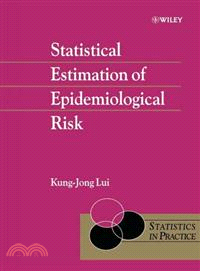Statistical Estimation Of Epidemiological Risk
商品資訊
ISBN13:9780470850718
出版社:John Wiley & Sons Inc
作者:Lui
出版日:2004/01/29
裝訂/頁數:精裝/206頁
定價
:NT$ 5491 元優惠價
:90 折 4942 元
若需訂購本書,請電洽客服 02-25006600[分機130、131]。
商品簡介
作者簡介
目次
商品簡介
Statistical Estimation of Epidemiological Risk provides coverage of the most important epidemiological indices, and includes recent developments in the field. A useful reference source for biostatisticians and epidemiologists working in disease prevention, as the chapters are self-contained and feature numerous real examples. It has been written at a level suitable for public health professionals with a limited knowledge of statistics.
Other key features include:
Provides comprehensive coverage of the key epidemiological indices.
Includes coverage of various sampling methods, and pointers to where each should be used.
Includes up-to-date references and recent developments in the field.
Features many real examples, emphasising the practical nature of the book.
Each chapter is self-contained, allowing the book to be used as a useful reference source.
Includes exercises, enabling use as a course text.
Other key features include:
Provides comprehensive coverage of the key epidemiological indices.
Includes coverage of various sampling methods, and pointers to where each should be used.
Includes up-to-date references and recent developments in the field.
Features many real examples, emphasising the practical nature of the book.
Each chapter is self-contained, allowing the book to be used as a useful reference source.
Includes exercises, enabling use as a course text.
作者簡介
KUNG-JONG LUI is a professor in the Department of Mathematics and Statistics at San Diego State University. Since he obtained his Ph.D. in biostatistics from UCLA in 1982, he has published more than 100 papers in peer-reviewed journals, including Biometrics, Statistics in Medicine, Biometrical Journal, Psychometrika, Communications in Statistics: Theory and Methods, Science, Proceedings of National Academy of Sciences, Controlled Clinical Trials, Journal of Official Statistics, IEEE Transactions on Reliability, Environmetrics, Test, Computational Statistics and Data Analysis, American Journal of Epidemiology, American Journal of Public Health, etc. He is a Fellow of the American Statistical Association, a life member of the International Chinese Statistical Association, and a member of the Western North American Region of the International Biometric Society.
目次
About the author.
Preface.
1 Population Proportion or Prevalence.
1.1 Binomial sampling.
1.2 Cluster sampling.
1.3 Inverse sampling.
Exercises.
References.
2 Risk Difference.
2.1 Independent binomial sampling.
2.2 A series of independent binomial sampling procedures.
2.2.1 Summary interval estimators.
2.2.2 Test for the homogeneity of risk difference.
2.3 Independent cluster sampling.
2.4 Paired-sample data.
2.5 Independent negative binomial sampling (inverse sampling).
2.6 Independent poisson sampling.
2.7 Stratified poisson sampling.
Exercises.
References.
3 Relative Difference.
3.1 Independent binomial sampling.
3.2 A series of independent binomial sampling procedures.
3.2.1 Asymptotic interval estimators.
3.2.2 Test for the homogeneity of relative difference.
3.3 Independent cluster sampling.
3.4 Paired-sample data.
3.5 Independent inverse sampling.
Exercises.
References.
4 Relative Risk.
4.1 Independent binomial sampling.
4.2 A series of independent binomial sampling procedures.
4.2.1 Asymptotic interval estimators.
4.2.2 Test for the homogeneity of risk ratio.
4.3 Independent cluster sampling.
4.4 Paired-sample data.
4.5 Independent inverse sampling.
4.5.1 Uniformly minimum variance unbiased estimator of relative risk.
4.5.2 Interval estimators of relative risk.
4.6 Independent poisson sampling.
4.7 Stratified poisson sampling.
Exercises.
References.
5 Odds Ratio.
5.1 Independent binomial sampling.
5.1.1 Asymptotic interval estimators.
5.1.2 Exact confidence interval.
5.2 A series of independent binomial sampling procedures.
5.2.1 Asymptotic interval estimators.
5.2.2 Exact confidence interval.
5.2.3 Test for homogeneity of the odds ratio.
5.3 Independent cluster sampling.
5.4 One-to-one matched sampling.
5.5 Logistic modeling.
5.5.1 Estimation under multinomial or independent binomial sampling.
5.5.2 Estimation in the case of paired-sample data.
5.6 Independent inverse sampling.
5.7 Negative multinomial sampling for paired-sample data.
Exercises.
References.
6 Generalized Odds Ratio.
6.1 Independent multinomial sampling.
6.2 Data with repeated measurements (or under cluster sampling).
6.3 Paired-sample data.
6.4 Mixed negative multinomial and multinomial sampling.
Exercises.
References.
7 Attributable Risk.
7.1 Study designs with no confounders.
7.1.1 Cross-sectional sampling.
7.1.2 Case–control studies.
7.2 Study designs with confounders.
7.2.1 Cross-sectional sampling.
7.2.2 Case–control studies.
7.3 Case–control studies with matched pairs.
7.4 Multiple levels of exposure in case–control studies.
7.5 Logistic modeling in case–control studies.
7.5.1 Logistic model containing only the exposure variables of interest.
7.5.2 Logistic regression model containing both exposure and confounding variables.
7.6 Case–control studies under inverse sampling.
Exercises.
References.
8 Number Needed to Treat.
8.1 Independent binomial sampling.
8.2 A series of independent binomial sampling procedures.
8.3 Independent cluster sampling.
8.4 Paired-sample data.
Exercises.
References.
Appendix Maximum Likelihood Estimator and Large-Sample Theory.
A.1: The maximum likelihood estimator, Wald’s test, the score test, and the asymptotic likelihood ratio test.
A.2: The delta method and its applications.
References.
Answers to Selected Exercises.
Index.
Preface.
1 Population Proportion or Prevalence.
1.1 Binomial sampling.
1.2 Cluster sampling.
1.3 Inverse sampling.
Exercises.
References.
2 Risk Difference.
2.1 Independent binomial sampling.
2.2 A series of independent binomial sampling procedures.
2.2.1 Summary interval estimators.
2.2.2 Test for the homogeneity of risk difference.
2.3 Independent cluster sampling.
2.4 Paired-sample data.
2.5 Independent negative binomial sampling (inverse sampling).
2.6 Independent poisson sampling.
2.7 Stratified poisson sampling.
Exercises.
References.
3 Relative Difference.
3.1 Independent binomial sampling.
3.2 A series of independent binomial sampling procedures.
3.2.1 Asymptotic interval estimators.
3.2.2 Test for the homogeneity of relative difference.
3.3 Independent cluster sampling.
3.4 Paired-sample data.
3.5 Independent inverse sampling.
Exercises.
References.
4 Relative Risk.
4.1 Independent binomial sampling.
4.2 A series of independent binomial sampling procedures.
4.2.1 Asymptotic interval estimators.
4.2.2 Test for the homogeneity of risk ratio.
4.3 Independent cluster sampling.
4.4 Paired-sample data.
4.5 Independent inverse sampling.
4.5.1 Uniformly minimum variance unbiased estimator of relative risk.
4.5.2 Interval estimators of relative risk.
4.6 Independent poisson sampling.
4.7 Stratified poisson sampling.
Exercises.
References.
5 Odds Ratio.
5.1 Independent binomial sampling.
5.1.1 Asymptotic interval estimators.
5.1.2 Exact confidence interval.
5.2 A series of independent binomial sampling procedures.
5.2.1 Asymptotic interval estimators.
5.2.2 Exact confidence interval.
5.2.3 Test for homogeneity of the odds ratio.
5.3 Independent cluster sampling.
5.4 One-to-one matched sampling.
5.5 Logistic modeling.
5.5.1 Estimation under multinomial or independent binomial sampling.
5.5.2 Estimation in the case of paired-sample data.
5.6 Independent inverse sampling.
5.7 Negative multinomial sampling for paired-sample data.
Exercises.
References.
6 Generalized Odds Ratio.
6.1 Independent multinomial sampling.
6.2 Data with repeated measurements (or under cluster sampling).
6.3 Paired-sample data.
6.4 Mixed negative multinomial and multinomial sampling.
Exercises.
References.
7 Attributable Risk.
7.1 Study designs with no confounders.
7.1.1 Cross-sectional sampling.
7.1.2 Case–control studies.
7.2 Study designs with confounders.
7.2.1 Cross-sectional sampling.
7.2.2 Case–control studies.
7.3 Case–control studies with matched pairs.
7.4 Multiple levels of exposure in case–control studies.
7.5 Logistic modeling in case–control studies.
7.5.1 Logistic model containing only the exposure variables of interest.
7.5.2 Logistic regression model containing both exposure and confounding variables.
7.6 Case–control studies under inverse sampling.
Exercises.
References.
8 Number Needed to Treat.
8.1 Independent binomial sampling.
8.2 A series of independent binomial sampling procedures.
8.3 Independent cluster sampling.
8.4 Paired-sample data.
Exercises.
References.
Appendix Maximum Likelihood Estimator and Large-Sample Theory.
A.1: The maximum likelihood estimator, Wald’s test, the score test, and the asymptotic likelihood ratio test.
A.2: The delta method and its applications.
References.
Answers to Selected Exercises.
Index.
主題書展
更多
主題書展
更多書展今日66折
您曾經瀏覽過的商品
購物須知
外文書商品之書封,為出版社提供之樣本。實際出貨商品,以出版社所提供之現有版本為主。部份書籍,因出版社供應狀況特殊,匯率將依實際狀況做調整。
無庫存之商品,在您完成訂單程序之後,將以空運的方式為你下單調貨。為了縮短等待的時間,建議您將外文書與其他商品分開下單,以獲得最快的取貨速度,平均調貨時間為1~2個月。
為了保護您的權益,「三民網路書店」提供會員七日商品鑑賞期(收到商品為起始日)。
若要辦理退貨,請在商品鑑賞期內寄回,且商品必須是全新狀態與完整包裝(商品、附件、發票、隨貨贈品等)否則恕不接受退貨。























